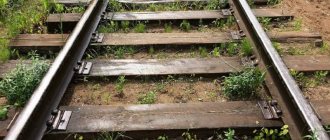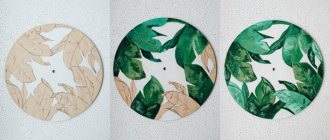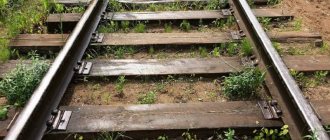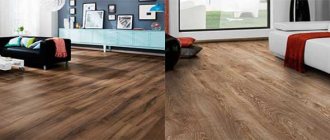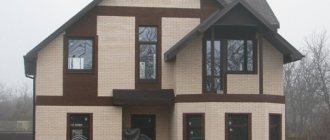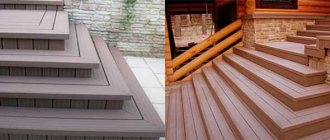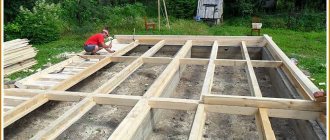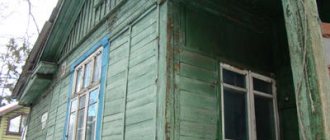Sleepers are used when laying railway tracks as a support for rails. Crushed stone or gravel is poured and leveled onto the earthen platform - the so-called “ballast layer” (ballast), on which sleepers are laid.
Ballast allows you to evenly distribute the load received from the sleepers, and prevents them from moving sideways or longitudinally when a train passes. The thickness of such a layer is at least 0.3 meters. Recently, crushed stone is used less frequently, replacing it with concrete.
In turn, the sleepers take on the load from the rails and maintain their stability, preventing them from shifting under the pressure of moving or braking trains. Sleepers keep the track gauge constant. The rails are attached to the sleepers with special screws or “crutches”. Sleepers and rails act as a kind of shock absorber, preventing the ground from subsiding under the weight of a multi-ton train.
Sleepers can be made of wood, reinforced concrete, or composite. Several years ago, up to 90% of the sleepers on the tracks were wooden. Today, only slightly more than half of all sleepers laid are made of wood. When constructing new railways and repairing old ones, wooden sleepers are replaced with reinforced concrete ones.
Pros and cons of wooden sleepers
Despite the fact that the number of composite and reinforced concrete sleepers used is constantly increasing, wooden sleepers will not leave the market for a long time due to their undeniable advantages.
Advantages of wooden sleepers:
- high elasticity;
- ease and simplicity of production and processing (the production of wooden sleepers is cheaper than the production of reinforced concrete ones);
- allow you to adjust the track width in curves with a small radius;
- a simple way to attach rails to them;
- strong adhesion to the ballast layer;
- resistance to mechanical shocks and force loads;
- resistance to temperature changes;
- light weight (three times lighter than reinforced concrete);
- a railway track with wooden sleepers has less rigidity than with reinforced concrete ones;
- low electrical conductivity (accordingly, better electrical insulation of rails).
Pine wood is best suited for the production of sleepers; spruce, fir, cedar, larch and birch are also used.
First, the wood is cut and the timber is obtained in the correct shape. Then sleepers are made from it, according to the dimensions approved by GOST. After mechanical processing, the manufacturer performs an antiseptic treatment and places his mark on one of the ends of the sleeper.
Sleepers are impregnated with coal oils, creosote, and antiseptics.
During operation, sleepers are exposed to the destructive effects of precipitation, dynamic loads, and temperature changes. As a result, defects appear, such as:
- Longitudinal cracking and splitting at the end ends. In this case, the internal parts not treated with protective substances are opened. As a result, the sleeper quickly becomes unusable;
- Deformation and rotting under the fastenings of the linings.
In addition to the defects that arise, wooden sleepers have a number of disadvantages:
- short service life - 15 years (reinforced concrete ones last from 30 to 50 years);
- the high price of timber from which sleepers are made;
- low wear resistance of wood;
- recycling problem.
ZhTK
This is what they treat railway sleepers with when they want to prevent the heating wood from emitting carcinogens into the atmosphere during their operation. The abbreviation simply stands for thermocondensation liquid. This is a petroleum product similar to oil, produced using a patented technology. This product is directly supplied to manufacturing plants of VSP elements; it is not publicly available. Advantages:
- extending the service life of supporting structures to 20 years;
- protection without the formation of a sticky layer on the surface, without clots and compactions - the smoothness of the profile is not disturbed;
- there is no smell, the color of the wood practically does not change (it only becomes a little lighter, which does not worsen the visual impression);
- non-toxic, does not emit harmful substances into the atmosphere, and therefore does not contribute to the occurrence of cancer.
These advantages determine the breadth of use of ZhTK. So, we have found out what railway sleepers are impregnated with, and now let’s see how exactly (that is, in what sequence) they are processed when released.
Average service life after processing of wooden sleeper supports
This time reaches 15-20 years, and in the absence of damage to the track bed it even exceeds this figure, and this is for all types of supporting structures that can be edged, that is, with cuts on all four sides, semi-edged (only three surfaces) and unedged ( sawn partially or only at opposite ends).
Application
Wooden sleepers can be used in any laying areas: link tracks with wider gauges, narrow gauge tracks, curves with a small radius (up to 300 meters), on swampy soils, in permafrost zones, on unstable soils, on tracks with high freight traffic.
The use of wooden sleepers is more effective than reinforced concrete sleepers on continuous continuous tracks that are intensive in cargo transportation.
Plastic
This material is still rarely used for the manufacture of sleepers, but production is gradually increasing. The leader here is the USA, producing up to 15 million sleepers per year (their approximate cost is 500 million dollars). For the production of plastic sleepers, composite materials are used, which have proven themselves in the construction of bridges (cladding). The same composite composition is widely used for the manufacture of sea piles and berths.
The production is carried out by several companies that have managed to agree on sleeper standards and conduct their tests. The weight of the products is 200-280 pounds (production technology and product length play a role here).
Parameters of wooden sleepers
The GOST 78-2004 standard, in force since 2006, is used in the countries of the customs union and clearly regulates the parameters and class of wooden sleepers. There are 3 classes in total, the first is the highest. Dimensions are set depending on the class.
So, for class 1, the thickness is set to 1.8 m, the height of the sides (sawed) is 1.5 m, the width of the side at the top is 1.8 m and 2.1 m, at the bottom - 2.5 m. For sleepers of class 3: thickness 1, 5 m, height of the sides (sawed) 1.05 m, width of the upper side 1.4 m and 1.9 m, bottom - 2.5 m. The total length of the three classes is 275 cm. For these parameters, wood moisture content of up to 22% is required . If the humidity level is higher than normal, allowances for drying are required (GOST 6782.1-75 and GOST 6782.2-75).
A prerequisite is antiseptic impregnation of the sleeper before laying and marking on the end.
Size, length
Standard length 275 cm (+/- 2 cm). For tracks with high freight traffic, the length can be increased to 280 cm. For tracks with different gauges, the length can be 3 m.
Weight
The weight of coniferous wood sleepers ranges from 80 to 85 kg.
What is the best way to finish a bathhouse made of sleepers so that creosote does not seep through?
I personally didn’t, although the sleepers were free. It’s better to let the log lie on the stone. It is better to go through it with a modern antiseptic. Rexby
01-08-2008 09:34
Today, waste wooden sleepers are one of the main environmental problems of Russian Railways. The sleepers are impregnated with an antiseptic containing phenol, hence the harmfulness. They belong to the 3rd class of environmental hazard - moderately hazardous waste (a total of 5 hazard classes). Therefore, they cannot even be placed in landfills ( Only waste of hazard class 4-5 is allowed to be placed there). And even more so, sleepers cannot be given to the population, but we used to do this, and houses were built from them, although our region is not poor in forests.
Sportsman
01-08-2008 09:51
Abar
01-08-2008 10:54
SergeyVS
07-08-2008 11:12quote:Originally posted by DIZZI:
Sergey, many people do this.
I personally didn’t, although the sleepers were free. It’s better to let the log lie on the stone. It is better to go through it with a modern antiseptic. How
DIZZI
08-08-2008 12:02quote:Originally posted by SergeyVS:
What
Yesterday I couldn’t ask
The stores are full of all kinds of antiseptics.
Oregonian
08-08-2008 07:17quote: I recommend everyone to stay away from sleepers - after 24 hours of lying in the garage in cool weather it stank so much that it gave me a headache. Well, I finally understood what it was.
From communicating with smart people, you yourself become like them. Pavel_A
08/12/2008 11:48
I'm sorry, but I live in a house like this, maybe the sleepers are different???
Oregonian
12-08-2008 17:38quote:
Ipat, but I live in a house like this, maybe the sleepers are different???
Or maybe I’m living, but not living?
sahara
12-08-2008 19:04quote:Originally posted by Sportsist:
I thought: am I a fool for building in a 100% forested region from stinking sleepers???
and people also... stare at them
Pavel_A
08/13/2008 20:50quote:Originally posted by Oregonian:
maybe I’m living, but not living?
We saw what your houses are built from, who the hell knows how they live in this chemistry, if the timber has been buried in the ground for 50 years, they dug it up, and it’s like new, and the electric poles on the streets are saturated with some kind of crap, they stand for 50 years without little boy. so the creazote before the bourgeois impregnation is just son.
Nikifor
20-08-2008 23:08
An acquaintance from Zheldorbatov told how they sold sleepers, new, smelly ones for the construction of bathhouses, and old weathered ones, he said nothing, they go to bathhouses...
Pavel_A
08/21/2008 09:15quote:Originally posted by Nikifor:
and the old weathered ones, he said nothing, they go to the baths
and say that after 20 years the creasote evaporates and the sleepers become less harmful. Oregonian
08/21/2008 10:35quote:
the electric poles on the streets are saturated with some kind of crap, they stand for 50 years without a guard.
Pasha, we don’t build houses with them.
come, I'll show you what houses are built from Oregonian
08/21/2008 10:36quote:
they say that after 20 years the creasote evaporates and the sleepers become less harmful.
They say that you can drink vinegar if you drink a glass of soda first. —————————————————— Try it.
Nikifor
21-08-2008 15:42
They drink vinegar in sips, and their health only improves.
next door there is an unfinished dacha. all made from old sleepers. It has been standing for 30 years without windows, ceiling or roof. Apparently this is one of the reasons
Surgeon2005
21-08-2008 18:42
Sleepers are evil. I speak as a person who worked directly with them on the tracks. About the weathering of creasote - well, in 20 years, under the rain or in running water, the creasote will probably wash away. Almost whole . And what is sold is usually out of the way, worn out. They are also covered with waste, diesel fuel, and other rubbish.
You say it stinks, out of habit, you wear it for a day, and the next day your face and hands look like they’ve been burned.
Petrus
29-08-2008 06:32
And one of my friends built a house from sleepers
Surgeon2005
29-08-2008 13:16
In fact, there are untreated sleepers. Rare, but also expensive. Or you need to have very successful acquaintances.
Personally, I have never seen this, but I know what happens
Serjant
29-08-2008 13:39
so at any sawmill..
Surgeon2005
08/29/2008 13:47quote:Originally posted by Serjant: what
is sawn timber called??: so in any sawmill..
No, no, no. Sawed timber of this size, by the way, is also rare, and is usually 6 meters long.
And sleepers are, in general, also timber, but of certain sizes. It’s just that they come out normal from under the saw, they are impregnated later, sometimes even during link assembly. This is where you can have an unsaturated marriage for free. According to rumors.
Sportsman
29-08-2008 15:32
screw the sleepers!
Home▲▼
Types of Wood Sleepers
Sleepers are divided into three types depending on the paths where they will be laid:
- For main (main tracks) (classes 1 and 2) and tracks with high freight traffic.
- For main tracks (classes 3 and 4) and marshalling tracks with high traffic intensity.
- For tracks of class 5, shunting, with low traffic intensity.
According to the cross section (its shape), sleepers are divided into:
- Edged - 4 sides are sawn - laid in the main tracks.
- Semi-edged - 3 sides are sawed through, the remaining two may not be sawed completely - used in tracks at stations and non-public tracks.
- Unedged - 2 opposite sides are sawn through - for non-public routes with low freight traffic.
It is permissible to use previously used sleepers removed during repair or construction work. Such sleepers are divided into categories:
- Category 1 – sleepers with wear up to 5 mm, without splitting through, without rot and with fastening hole sizes up to 24 mm. Allowed to be used on tracks of 1, 2 and 3 classes, as well as sorting.
- Category 2 - wear from 30 to 50 mm, cracks, end-to-end splits, mounting holes up to 4 cm are allowed. In addition, the length is allowed to be reduced to 250 cm after removing the rotten part of the end ends. Can be used on routes of 3 and 4 classes.
- Category 3 – this includes sleepers that are not included in the first two categories according to their characteristics, as well as composite sleepers that have the same type of material. Can only be used on class 5 tracks.
Notes
- ↑ 1 2 Sleeper
- article from the Great Soviet Encyclopedia. - ↑ 123456
Rail transport: Encyclopedia / Ch. ed. N. S. Konarev. - M.: Great Russian Encyclopedia, 1994. - 559 p.: ill. - ↑ 12
Hay 1982, pp. 437-438. - Hay 1982, p. 477.
- Grant 2005, p. 145.
- Metal sleepers metal4u.ru/articles/by_id/214
- Great Russian Encyclopedia: In 30 volumes / Chairman of scientific editor. Council Yu. S. Osipov. Rep. edited by S. L. Kravets. T. 9. Dynamics of the atmosphere - railway junction. - M.: Great Russian Encyclopedia, 2007. - 767 p.: ill.: map. (article Railway track)
Technical requirements for wooden sleepers
Sleepers must fully comply with GOST requirements. It should be added that the uncut sides of the sleepers must be completely cleared of bark. Knots are cut flush with the surface.
The manufacturer must treat the sleepers with oil-based protective agents. For storage, sleepers must be stacked in dry warehouses.
The quality of used sleepers must be regularly monitored. For this purpose, detours are provided. If any defects are found, they are immediately eliminated.
Sleeper means "support" in Dutch. Sleepers appeared in Russia in 1834, but to this day their era has not yet ended.
A little bit of history.
The word sleeper came to us from the Dutch during the time of Peter I, when more than a hundred years remained before the appearance of the first railway. And the original meaning of the word “sleeper” meant “support” (from the Dutch spalk).
Over time, the concept of “railroad sleeper”, and from a certain point onwards, this term has been used to designate specialized supports for rails, made in the form of beams. These beams are laid on the ballast layer of the upper track. It is the railway sleepers that take on the pressure that the rails create, while the intermediate fastenings transfer the pressure to the under-sleeper base.
Initially, wood was chosen as the main material for the production of railway sleepers, since it is a material available on an industrial scale and is easily processed.
